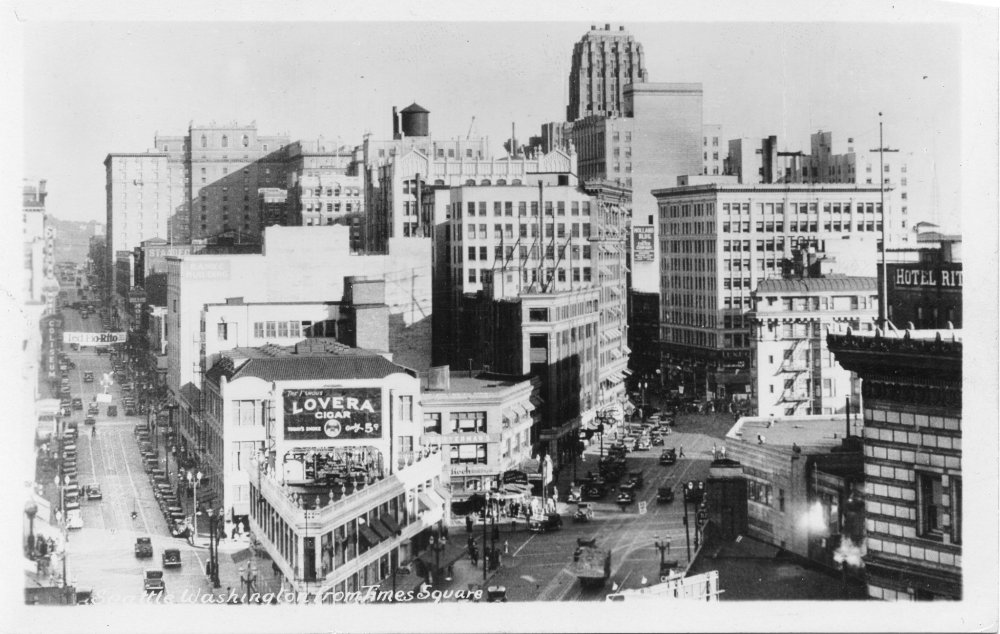This is an outtake from research for Bruce Ramsey’s new book, “Seattle in the Great Depression” (WSU Press, 2025), reviewed here .
On October 31, 1929, two days after the worst day on Wall Street in the 20th century, a group of Shriners is tucking into an elegant luncheon of reindeer meat at the Olympic Hotel. Their host, Paul E. Williams, 39, is a new man on Seattle’s financial row, and his Paul E. Williams Company has been selling stocks and bonds to the public for eight months. Backed by seed money from a retired California liquor wholesaler, H.C. Hunt, Williams has already opened offices in Centralia, Spokane, and Portland.

As the nation begins sliding into the Depression, Williams sets up sister companies in Oregon and California. The business reporters of the Seattle Times and Post-Intelligencer take note. While other financial houses are closing their doors (and a few of them jumping out of windows) the Paul E. Williams Company is expanding. Newspaper reporters would see the ads on the business pages day after day, promising that “constant supervision of your investment holdings is assured by the Paul E. Williams Company.” In October 1929, Williams opens a department for women investors. Later it offers an instalment plan to make the purchase of “seasoned New York listed stocks… as easy as purchasing an automobile.”
For the press, the Williams companies offer a positive story at a gloomy time. Business reporters would want to write stories like that. Decades later, I was a business reporter myself, at the Post-Intelligencer. That in 1929-1931 neither The Times nor The P-I ever profile Paul E. Williams and his hot new company tells me that the man won’t talk. He’ll buy ads but not answer questions. And he has good reason for his reticence. He cheats.
Williams’ duplicity begins by accident. Sometime in 1929, his lawyer will later say, Williams discovers that shares of stock a client paid for haven’t been bought. It’s an oversight. But by the time the company buys the shares, the price has gone down. The mistake results in a windfall profit. In the long bear market that begins in the fall of 1929, Williams begins delaying executions as a matter of course.
Williams’s installment plan is another version of pay-now-buy-later. Williams takes the down payment in cash and tells the customer the stock is being held as security for the loan. There isn’t any stock. And there isn’t any loan. Williams has to buy the stock only when the customer makes the last payment and orders the shares.
This thoroughly dishonest business plan works only when prices are falling, but for three years they fall most of the time.
The windfall profits help fund Williams’ expansion into Oregon and California. By the end of 1929, the Washington company alone has pretended to buy 21,672 shares. By the end of 1930, it has pretended to buy 59,771 shares.
In February 1931 comes the inevitable: For a few weeks during the longest bear market of the 20th century — also the month when Seattle’s largest savings and loan goes under — the stock market goes up. (The market is weird that way.) Williams can’t cover his bets. Frustrated by his delays, his customers file suit. In April 1931, his companies are put in the hands of a bankruptcy trustee. Hundreds of customers in the Williams companies of Washington, Oregon, and California lose an estimated at $1 million (about $21 million in today’s dollars).
In Seattle the most prominent loser is A.W. Leonard, president of the Puget Sound Power & Light Company (today’s Puget Sound Energy). Leonard has handed Williams 100 shares of Stone & Webster, then Puget’s parent company, as security for a loan to buy other stock. Williams doesn’t buy the other stock. Instead, he pledges Leonard’s shares for a loan from a Seattle bank. Williams spends the money and defaults on the loan. The bank seizes Leonard’s shares and sells them to pay off the loan. The bank makes a $3,645 profit on the shares, and sends that amount back to the bankruptcy trustee. Leonard files a claim for the $3,645, but the trustee says the money is in the common pot for all the creditors. Leonard sues the trustee and loses.
Williams responds to the collapse of his company by fleeing the state. Prosecutors delay filing criminal charges in the hope that police can find him, but they can’t. After seven months, he is discovered in Hot Springs, Arkansas, where he is promoting stock in an Arizona barite mine. He is arrested and brought back to Seattle in shackles. The state hands him over to the feds to face a charge of conspiracy and 10 counts of mail fraud. Williams pleads guilty to all of them and is sentenced to five years at McNeil Island penitentiary. He serves two years, and is released in July 1935.
SOURCES: Founding:ncorporations,” Seattle Times, 1-23-29, p. 22; first display ad, Times, 4-14-29, p. 35. Women’s dept.: display ad, Times, 9-22-29, p. 46. Instalment plan: ad, Times, 11-3-29, p. 38, 2-16-31, p. 21. The scheme: “Paul Williams Pleads Guilty to P.O. Frauds,” Times, 1-21-33, p. 3; Burdette v. Maryland Casualty Co. Div. 1, Calif. Appeals, 6-25-35. Company failure, Williams’ flight: “Investment Firm to Appear in Court,” Times, 4-17-31, p. 36; “Brokerage House Here in Receivership,” Post-Intelligencer, 4-24-31, p. 25; “Seattle Bonds Dealer Facing Theft Charge,” P-I, 5-20-31, p. 1. Arrest, sentence: “Fugitive Seattle Stock Head, Short Million, Found,” P-I, 9-2-31, p. 1; Chalcraft, “Jury Indicts Williams and 11 Associates,” P-I, 11-26-31, p. 1; “Guilty, Says Williams to Fraud Charge,” P-I, 1-21-33 p. 1; “Williams Gets 5 Years,” Times, 1-22-33, p. 1; release date, index card for Inmate 1257-FL, National Archives, Seattle. Leonard: Leonard v. Field, 71 F.2d 483 (9th Cir. 1934).
Discover more from Post Alley
Subscribe to get the latest posts sent to your email.
